Insights
Preparing for and Smashing the Tableau Desktop Specialist Certification Exam
- Category
- Blog
- Date published
- 09.05.2022

One of our Junior consultants Jonathan Hastings recently passed the Tableau Desktop Specialist Certification exam. After working with Tableau in one capacity or another for about 5 months he decided to take the plunge and go for certification. He has written this blog to provide you with a few canny tips and tricks that he used in order to aid others with their preparation.
What is the Desktop Exam?
The Tableau Desktop Specialist Certification tests foundational product knowledge. It is the lowest level of certification that Tableau has to offer and has no expiration date, unlike some of the more advanced certifications that Tableau has to offer.
The exam itself lasts an hour and there are 45 multiple choice questions to answer within that time. It is worth noting that 5 of these questions are unmarked, although these are not highlighted within the exam. To pass you’ll need to score at least 750 out of 1000, based on Tableau’s scaling system. All the questions presented are knowledge-based, and as such there’s no requirement to complete any hands-on exercises during the exam.
The exam costs $100 + VAT and, once you’ve paid, you have the ability to schedule your exam up to 6 months in advance. Depending on your Tableau usage, I’d recommend booking it sooner rather than later because I got super anxious that I would forget something if I waited too long to complete it.
Why it’s a good idea to get certified
Tableau is a widely used tool for data visualisation and business intelligence and is one of the most popular pieces of software in the industry. So, if you use data in any way within your professional or personal life, which should be just about everyone, getting up to scratch and certified is a great way to demonstrate your proficiency in the reporting field. More significantly, studying for the exam will give you a comprehensive knowledge of Tableau fundamentals. A skill that is heavily sought after in any field.
Getting certified also gives you the opportunity to connect with the wider Tableau community, something that is hugely beneficial when learning, and provides a space to discuss all things data. It’s also a great way to increase your understanding of Tableau and visualisation best practices – something I’ll get into later.
How to prepare?
Tableau eLearning
Tableau eLearning, specifically Desktop I: Fundamentals, was my first point of call when preparing for the Tableau exam. It provides self-paced learning modules that contain a mix of Tableau concepts, demos and interactive activities for each topic needed for the exam. Additionally, I found that completing the Desktop II: Intermediate course was also beneficial in refining my knowledge of the fundamental concepts. It helped to expand my knowledge on certain elements of the exam such as Tableau’s Order of Operations, use of sets, parameters, as well as some of the more advanced use cases for selected chart types.
As for the practical elements of the course, I found that using the ‘Hint’ dropdowns when running through the example was not very conducive to my learning, more of a cheat code really. In these interactive elements I would always recommend researching online or looking at how the visualisation should look, ‘expected result dropdown’, to guide you. This is not to say that you shouldn’t use them if you’re stuck, the hints are there for a reason. But trial and error is one of the most beneficial learning resources in Tableau, which I’ll get onto later.
One thing to note though, these eLearning modules do cost $10/user/month and are billed annually. I was grateful enough to have my employer cover this cost, so it’s worth asking your employer if they can cover this if you are a working professional.
If you are unable to receive access to these eLearning modules, udemy also offers a range of Tableau courses as well as ones specifically designed for the Desktop Specialist exam.
Hands-on practice
As with anything in the field, getting as much hand-on experience is imperative when preparing for the exam. As such, using Tableau for client facing work was invaluable to the preparation of my exam and I am so grateful for these experiences. This is also an incredible asset when building visualisations from scratch, which is something the eLearning modules don’t provide for you, as it makes you start to question visualisations: which chart type is best to represent your data; where to place sheets on a dashboard; how relationships differ to joins and which is best for your data sources; where best to place these chart into visualisations; and the persistent use of fundamentals.
As such, I would highly recommend asking your employer if there are any projects you can work on to elevate your Tableau skills and product knowledge. If this is not an option for you, there are a wealth of resources available online through:
Workout Wednesdays
Workout Wednesdays are an excellent resource provided by Tableau to refine your skills in a variety of specific features of Tableau. Struggling with Dashboard Actions, there’s challenges for that. Still can’t get your head around LOD calculations, there’s challenges for that too. For anything you want to upskill on, I’m sure there is a Workout Wednesday challenge for that. If you’re inexperienced, I would recommend starting with some that have answers provided by the Challenge Host or resident members of the Tableau community, just in case you do get stuck. Believe me, if I had a penny for the number of times something wasn’t working in my visualisations, well you know the adage.
As noted, the benefit of these is an endpoint. A final visualisation is provided, which you can interact with as well, so it gives you a reference point to attain. It’s hard when you’re starting out to visualise how you want your dashboard to look at the end, so having these references can nudge you into creating the right charts to start with.
Data Sets
If this doesn’t work out for you, as some of them are difficult for beginners, I would recommend grabbing a data set online or just making up random data in something you’re interested in. Then you can just get stuck in creating your visualisations.
Another excellent way to refine your knowledge is by observing already built dashboards on either Tableau Public or SportsVizSundays and trying to recreate them. There’s no assistance or guidance for this so it is a rogue option but gets you thinking about the overall picture in how these dashboards are constructed. More importantly though, it gets you thinking about how the underlying fundamentals of Tableau are used to create them.
Additional Notes
As wonderful as it in building visualisations, the one thing that really aided in my exam practice was breaking visualisations. This helps to highlight how Tableau works as a visualisation tool. Mess around and have fun with your visualisations. If something doesn’t work, you’ll figure out why, then you can fix or improve it.
More importantly, start to visualise Tableau actions in your mind prior to executing them. There’s no assistance in the exam and you will be required to know how to execute certain actions in Tableau without it being there as a visual que. Knowing the steps to, say, add a running total to a cross tab off the top of your head, will be hugely advantageous when you go to sit your exam.
Discussions
Start having discussion around Tableau. Tableau is an ethos as much as it is a reporting tool. So, whether that is by asking question to the community, answering questions that people have posted, if you’re feeling confident, or even just reading responses on the community boards. It’ll get you thinking about your data and provide help tips along the way.
Have discussions with your team about your creations, better yet, create a dashboard with members of your team that doesn’t understand it. This will not only introduce them to the wonders of Tableau, but also, they may bring up ideas that you never thought of. Or maybe they bring up ideas you know can’t work. This will allow you to explain the reasoning behind this and even use your fundamental knowledge to back up your responses.
How to Succeed
Finally, Tableau provides an exam preparation document that I would implore you to read over, for obvious reasons. Go over the points that it details could be tested on the exam, as this is by no means the extent of the test content, but it is a large basis of what will be tested. Sit with it, read through it, run through each aspect of the test criteria and think about how you would achieve this without Tableau open.
As well as this, Lukas Halim provides a wonderful resource here: https://learningtableau.com/specialist-practice-questions/, which contains a number of practice tests broken down by each section of criteria to test yourself.
Final Little Bits
The biggest piece of advice I have is just to go for it. If you feel like you’re ready, you are. Most of all enjoy it, explore it, and show it. You’ll soon see how Tableau can benefit your life.



